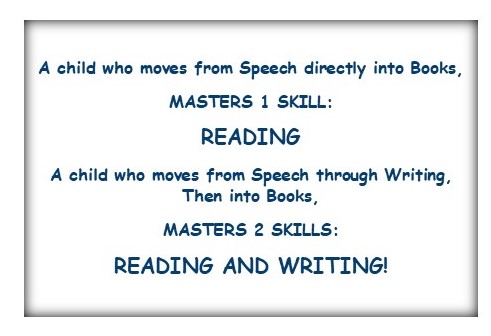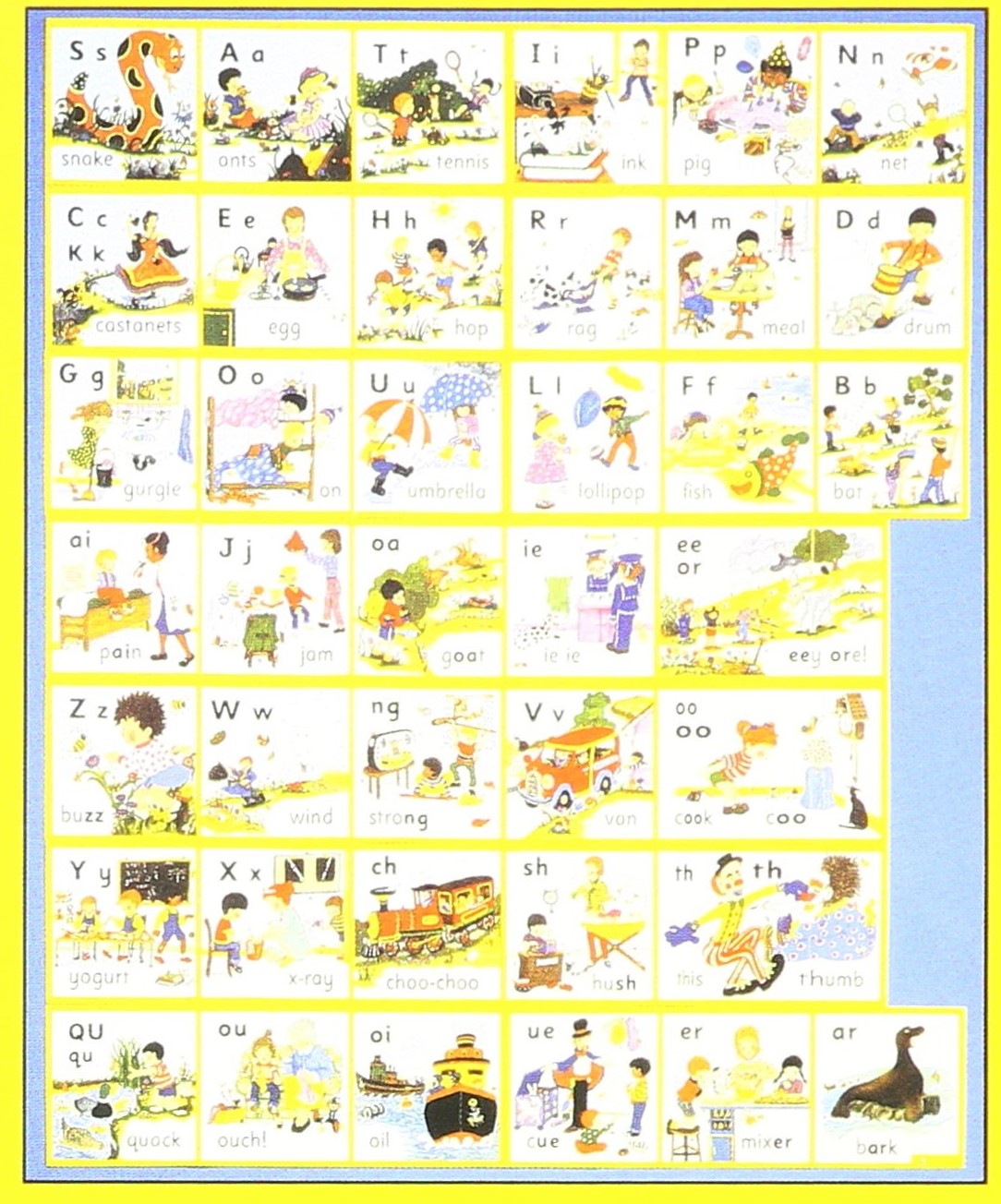Absorbing and Developing Phonics Naturally
In this approach, we don’t treat phonics as an isolated memory exercise, as if it were the multiplication table. Instead, we follow how a child learns naturally — in much the same way, for instance, we help them learn to speak.
This page shows you how to do that. First, here’s a brief look at what we’re doing and why:
With speech, we emphasize the words associated with something that has strong meaning for the child, as they watch and listen. Then while we can’t see exactly how they develop the skill to do it, some time later, we hear them using those same words, associated with that same meaning.
Using a similar process — yet much more carefully planned — we gradually use Key Words to show a child how to use the sound/symbol relationship to translate their own “talk” into print.
Key Words are the captions for the child’s “mind picture.” They represent something the child is very interested in — something they love, fear, want, or are simply intrigued with. As such, Key Words are an extremely valuable learning tool. For research has shown that interest is a powerful magnet for learning.
So we have the child tell us about something that’s on their mind. Then we have them watch us spell a Key Word or two that describes what they’ve said. Together, we “read” the Key Word back, then the child draws a picture about it and adds the word to the picture. We include this in the child’s own Writing Book.
Based on their own interests, and guided gently in this way, writing becomes interesting, easy, and “fun.”
But beyond that, doing this day after day, a child automatically begins to absorb not only phonics, but a multitude of other reading skills. And with this, once a child is writing independently, reading what others have written in books is not far behind.
Following is how to develop a strong phonics base as we move a child from speech into print in this way. The directions are designed for anyone working with one or more children at home, and of course, can be adapted for use at school.
Introduce the Alphabet
As you begin to address phonics, you need to be sure the child is familiar with the concept of the alphabet. If not, first teach them to sing the Alphabet Song, to the tune of “Twinkle, Twinkle Little Star.”
 Later, slowly sing the song together, as you point to each letter on an
Later, slowly sing the song together, as you point to each letter on an 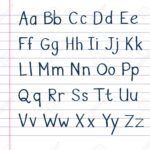 alphabet chart. You can simply print a copy of this alphabet chart, or make one yourself, using a Century Gothic font.)
alphabet chart. You can simply print a copy of this alphabet chart, or make one yourself, using a Century Gothic font.)
This activity is only so they know what you mean when you speak of the alphabet and say the name of a letter. This is not a memory task. They do NOT need to memorize the name of every letter before you begin with the two phonics activities described next. That will naturally occur as they work with Key Words. They just need to know what you’re talking about when you refer to a “letter.”
Two Simple Activities To Help a Child Develop Phonetic Skills
As the child is becoming familiar with the alphabet in this way, you also begin to carry out the following two basic activities:
1. Phonemic Awareness: Playing With “Today’s Sound.” Draw the child’s attention to one sound per day and have them play with it. Print one letter on a piece of letter-size paper, using Comic Sans font. Draw the child’s attention to the common sound that letter makes.
Again, this is not so they memorize the names or sounds, although they may begin to remember them. This is so they can readily notice, hear and differentiate between the different sounds in their own Key Words. (Work on just one sound a day, starting with consonants, then vowels, then digraphs, etc.).
Here are some ideas to get you started. Have them —
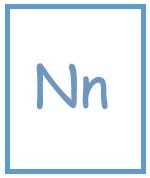
- Say their name, substituting today’s sound. (If the sound is “N” and their name is Donny, they say, “Nonny”)
- Repeat this with what they’re wearing and with objects around them.
- Name objects in the room or clothing they’re wearing that start with that sound.
- Bring objects to you that begin with that sound.
- Make up other ways to play with that sound.
Before you end this session, put the large letter on or near an object that begins with that sound. Place it where the child will see it often. Refer to occasionally, asking them to put a new object beside it that starts with that sound. (But do NOT begin using these letters to ask them to tell you the sounds from memory. Testing them may confuse what’s known as a 3-Part Lesson.*)
As you end this session, give the child a magazine and suggest they cut out pictures that start with that sound. Leave them to it — then later, check the pictures they found and explain any mistakes. Help them paste the pictures onto the paper you made with the large letter on it. Save it to create a growing “Alphabet Sound Book.” (Use a binder if you have one handy.)
2. Spelling Key Words. At another time that same day, have a session with Key Words. For detailed directions, see Working Through The Steps With Key Words. If your child is very young, also read, Key Words With Preschoolers.
Start any child at Step 1 who’s new to Key Words — even a child who already know something about reading and writing. For at first you’re just getting them used to the procedure. Later you can move them forward into the Step appropriate for them.
As you write the child’s Key Word for them, draw their attention to the letters needed to spell each day’s new Key Word— even if that day’s word does not use the sound you chose to emphasize in your phonemic awareness play. The idea is just to get them to focus on the sound/letter connections, and it doesn’t have to be done strictly in sequence or coordinated with Today’s Word. (This, as a true Key Word cannot be something contrived to fit with your other activities. It must come from the child’s mind/heart.)
Eventually, with the combination of phonemic awareness play and watching each day as you write their Key Word, the child will soon absorb enough of the connections to help supply some of them. After repeated experience with this, they have enough of those connections to begin writing on their own. For more on their 6-Step progression toward reading, see Working Through the Steps With Key Words, to see the overview of all the Steps.
*** PLEASE PAUSE HERE***
You now have a simple, yet effective strategy to help your child develop phonics skills. Day after day they will be absorbing phonetic connections — just by helping you supply the letters needed to spell their Key Words.
These skills will readily transfer to both writing and reading. Before long, they will spontaneously begin to write independently. Writing simple stories to describe what’s on their mind, they will be expanding their memory of phonetic connections. For as Montessori tells us, young children absorb information effortlessly.
They will naturally “read back” their own stories, and they will soon notice that those same words also appear in signs, notes you write, and in books. So reading will emerge naturally from this entire process.
But if you also want to explore more systematic ways to develop strong phonetic connections — and especially if you’re a classroom teacher — read on.
Alphabet/Noun Charts and Sound/Story Cartoon Systems
Again, the phonics activities described so far can be done with no special phonics pictorial materials of any kind — just the alphabet chart you made up yourself. But for a more thorough treatment, we look now at 2 types of professionally designed phonics materials that can be used instead of the chart described earlier that you would make up yourself:
1. letter/Noun Charts. Most classrooms have this kind of chart: “A” is for Apple, “B” is for Baby, “C” is for Cat, etc. You can buy one online. They are good for pointing out the one most common way to spell the different sounds in English.
But they don’t show all the uncommon ways some of the sounds can be spelled. And in English, there are many. For instance, the “S” sound as is “step,” can also be spelled with a “C” as in cent. Yet an alphabet noun chart doesn’t reflect this. So these charts are limited when it comes to spelling.

2. Story/Sound Systems. The picture here is an example of this type of system. It has a chart for each of the sounds spoken in English. Each chart connects a sound to the story suggested by a cartoon and shows the common way that sound can be spelled. Some also add the uncommon way(s).
But if a chart does not show all uncommon ways, you add them as you work with the children. Here, if a child asks to spell “know,” you simply write “kn” under the “N n” already there.
So bottom line: You do not need to know ahead of time all the ways to spell each sound in English to use this type of system. And — when you find an uncommon way missing, you just add it yourself.
Phonemic Awareness Activities With A Sound/Story System
You make up a story to go with each cartoon, for the stories need to resonate with the child you’re working with. For instance, the story here could be, “The insects and birds are buzzing around the man. The girl and the airplane are making an “Nnnnn” sound. So he’s holding his ears and feeling a little crazy.”
In the phonemic awareness activity, the child would listen to the story, then make the “Nnnnn” sound while holding their ears. They might also pretend to duck so they don’t get hit by the plane. Children love acting this out and usually remember the cartoon associated with that sound, from then on.
After the first session, here’s how subsequent sessions go —
- Review Sounds. Before introducing each day’s new sound, review previous sounds by showing the cartoons in quick succession while the child calls out the sound. (You might also mention the story briefly, but it’s not usually necessary.)
- Introduce Today’s Sound. Work with just ONE new cartoon a day. For the new sound, tell a very brief story suggested by the cartoon, ignoring the letter that appears on it. The focus is only on distinguishing the sound itself, plus connecting the story to the cartoon. IGNORE the letter and word on the chart — for now.
 Play With the Sound. Have the children play with the sound:
Play With the Sound. Have the children play with the sound:
- Feel the sound, as the children in the picture are feeling how the “Nnnnn” sound vibrates their nose,
- Identify whose name begins with that sound,
- Listen as each child substitutes Today’s Sound for the beginning sound of their name,
- Identify some things that begin with the sound. This might be one of their own physical attributes or an article of clothing they’re wearing. Or it might be having them find things in the room that start with the sound.
End by placing the cartoon on display on or near something that starts with that sound. Refer to it occasionally during transition times, by having a child add objects to it.
Create a Sound/Story Chart For Beginners
To create a chart for beginners, copy and reduce the large cartoons enough to fit all of them together on one chart. Place it where to be able to see it, the child must get up and walk away from where you’re sitting as you work on Key Words together. Here’s an example of the first row of the chart: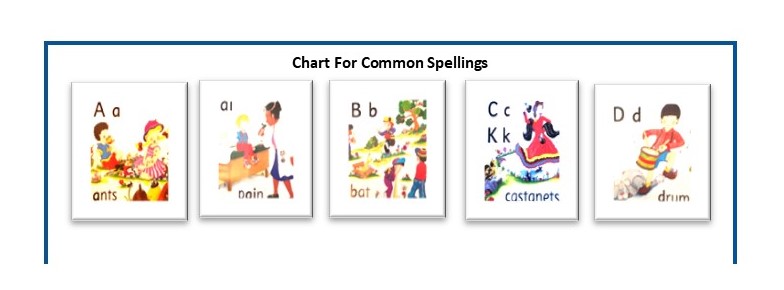 Using The Sound/Story Chart For Beginners At Steps 2 — 4
Using The Sound/Story Chart For Beginners At Steps 2 — 4
A child operating at Steps 2 – 4, uses the chart to spell the ONE new sound you find they need to focus on each day:
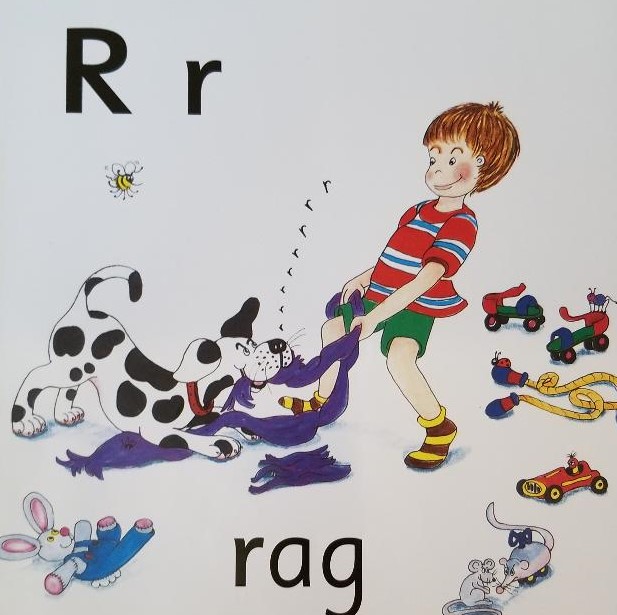 As you write the child’s Key Word, say each sound as you go, hesitating between letters — waiting to see if the child can supply any of the letters needed to spell it. For example, a child has been working at Step 2 for awhile and knows how to use the chart. They’ve asked for “robbers.” So you would pause and make the “Rrrrr” sound, asking if they remember how to spell that sound. If not, ask which cartoon makes that sound. If the child doesn’t remember, they remind them of the dog growling. “Rrrrr.”
As you write the child’s Key Word, say each sound as you go, hesitating between letters — waiting to see if the child can supply any of the letters needed to spell it. For example, a child has been working at Step 2 for awhile and knows how to use the chart. They’ve asked for “robbers.” So you would pause and make the “Rrrrr” sound, asking if they remember how to spell that sound. If not, ask which cartoon makes that sound. If the child doesn’t remember, they remind them of the dog growling. “Rrrrr.”
- Have the child leave you to look for the cartoon with that story on the chart. When they find the “rrrrrrrr’s” coming from the dog, they return to show which letter is needed. Have them trace it on the table, with the index finger of their writing hand. (If they forget, they have to go back to look again. Needing to keep in mind the sound/letter connection for that long, most children will remember that it the next time they need it.) So we’re capitalizing on their ability to absorb connections — just as we do when we help a child learn to speak.
As the child proceeds through the Steps, they absorb all the common ways to spell the sounds. And that’s where these sound/story charts become valuable. For again, you can add to them the uncommon way the sound is spelled.
Independent Writers (Steps 5 & 6) Use A Wall Strip Dictionary For Spelling
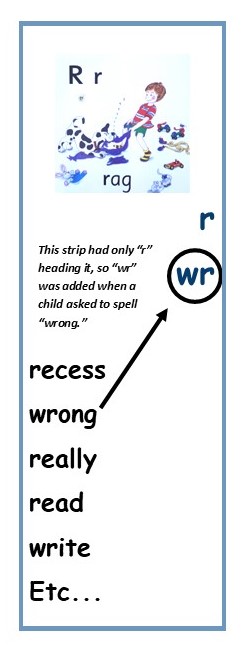 Another advantage: You can also use the sound/story cartoons as a support for spelling. After reducing them, they can either be used in book form — 2 cartoons on each page, with space beneath each for writing words — or if you’re working with more than one child, you can make a Wall Strip Dictionary, shown here, that they both will use. (With more than one child, the children much prefer the Wall Strip Dictionary — it seems to be intriguing for them to work together on a common device.)
Another advantage: You can also use the sound/story cartoons as a support for spelling. After reducing them, they can either be used in book form — 2 cartoons on each page, with space beneath each for writing words — or if you’re working with more than one child, you can make a Wall Strip Dictionary, shown here, that they both will use. (With more than one child, the children much prefer the Wall Strip Dictionary — it seems to be intriguing for them to work together on a common device.)
The set of strips hangs from cup hooks, in alphabetical order. When a child needs to spell a word, they walk along the row of strips and find the cartoon for the beginning sound of the word they need. Once they find the correct story, the child first looks to see whether the word they need is already written on the strip (because someone else had previously asked for it). If yes, they take it to a table and copy it.
If they don’t find the word there, they take the strip it to you. First you check to see if the word is already there. If so, cover the words below and above it — leaving 4 or 5 words for the child to choose from. A child will then usually recognize the one they need and copy it. If the word is not there, the child helps supply the letters needed, as you spell it. (Children don’t write on the strips.)
Again, rest assured that you do not need to know ahead of time all the different ways the many sounds in English can be spelled. All you need is a chart that isolates each of the sounds spoken in English and ties each to a cartoon story. If an uncommon way to spell one of the sounds is missing from the Wall Strip Dictionary you’ve made, you simply add it as shown here.
Again, please recall that you can accomplish a lot with a simple alphabet chart and Key Words. You don’t need to use a more complex phonics system.
One More Benefit To Beginning with Writing that Incorporates Phonics
Some children can successfully skip over writing and go directly into reading books, while others will struggle. But beginning instead by incorporating phonics into the writing process with Key Words significantly broadens what any child will accomplish. For please notice that —
Overview Of One Version Of Sound/Story CartoonsThere are several versions of Sound/Story Cartoons. Here’s a photo of the set by Jolly Phonics. It was brought to our attention by a member of the Facebook group, Helping All Kids Learn To Read. Although it’s missing some of the uncommon ways to spell every sound, it is well done and costs less than $15. To see it on Amazon, search for Jolly Phonics Frieze. |
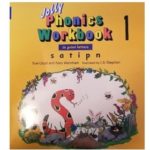 The Jolly Phonics program also has corresponding workbooks with practice activities for each letter. These could be used for choice activities — or for practice at a different time of day — so they do not interfere with the child’s creative writing. For writing is so central to everything else, that I recommend a lengthy period of time during which the child concentrates only on Key Words and The Step appropriate for them.
The Jolly Phonics program also has corresponding workbooks with practice activities for each letter. These could be used for choice activities — or for practice at a different time of day — so they do not interfere with the child’s creative writing. For writing is so central to everything else, that I recommend a lengthy period of time during which the child concentrates only on Key Words and The Step appropriate for them.
The time spent will vary, of course, but care should be taken that the child had plenty of time to write. Separate practice, math work, or other activities should be scheduled at a different time of the day. (For classrooms, where students finish writing at different times, please see CLASSROOMS, A Supportive Environment, for choice activities, of which these workbooks could be one choice available to them.)
—> next Projects — For All Ages
<— back to Key Words With Preschoolers
Questions/Comments: KidsWriteToRead@yahoo.com
*TBD: Link to a Montessori 3-Part Lesson
